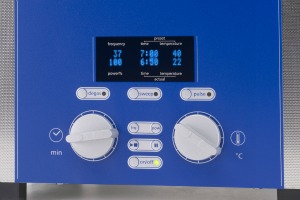Setting Ultrasonic Cleaner Power, Frequency and Time
In addition to using the correct temperature and cleaning solution formulation, achieving optimum results in an ultrasonic cleaning operation calls for a correct “blend” of ultrasonic power, ultrasonic frequency and cleaning time. Absent a proven recipe the three ingredients often are established through experimentation using ultrasonic cleaners that provide the flexibility to vary power, frequency and time.
Indeed, it may turn out that a fixed frequency and fixed power setting do not deliver the desired results. Adjustable power and adjustable frequencies may be the key to optimized cleaning action thereby reducing the time needed to complete jobs and improve operation efficiency.
A Brief Brief on Ultrasonic Power and Frequency
Power in this post is defined as the electrical energy in watts per gallon of cleaning solution delivered to the transducers that provide cavitation action in the cleaner. More power generally means faster cleaning but only to a point, beyond which you’re wasting electricity and may also damage parts.
Ultrasonic frequency is expressed in kilohertz (kHz) or thousands of cycles per second. Lower frequencies deliver larger cavitation bubbles that implode more vigorously on objects than the relatively smaller bubbles produced at higher frequencies. Lower frequencies are great for removing gross contaminants on cast or fabricated products but may damage polished or soft metal surfaces; high frequency cavitation is better for delicate surfaces and for penetrating small cracks, crevices and blind holes.
Read more about this topic in our post on selecting ultrasonic frequency and power.
A Solution to Ultrasonic Cleaning Process Development
Many ultrasonic cleaners on the market operate at a fixed frequency such as 37 kHz and an average power of 50 to 100 watts per gallon. When developing new cleaning procedures or when cleaning a variety of products, ultrasonic cleaning service providers should consider multi-frequency equipment with adjustable power along with other variables discussed below. An example is the Elmasonic P series of cleaners available from Tovatech. Its control panel lets operators perform the following adjustments and displays the set frequency, power, the set and remaining time, and the set and actual temperature:
- Power level can be adjusted in 10% steps from 100% to 30%
- Temperature options can be set in 5⁰C increments from 30⁰ to 80⁰C
- Frequency options are 37 kHz for normal cleaning or 80 kHz for delicate cleaning. The equipment provides the option to auto-switch between the 2 frequencies at 30 second intervals. This is an ideal feature for products with several contaminant challenges.
- The timer can be set in minute increments to an hour with auto switch off, or permanent on.
- An auto-start feature initiates cavitation at the set temperature. An automatic shut-off activates at 12 hours.
Additional feature of the P series include:
- A pulse mode button to increase cleaning power 20%. This is user activated to clean stubborn contaminants from surfaces.
- A sweep mode to optimize sound field distribution in the cleaning solution.
- A user activated degas mode for preparing new cleaning solutions.
- A pause button to interrupt the cycle for product inspection.
Selecting ultrasonic cleaning equipment offering programmable cleaning cycles facilitates the development of improved cleaning procedures. The result: faster, more thorough cleaning operations for a wide range of products.
Contact the ultrasonic cleaning professionals at Tovatech for more information on multi-frequency equipment that can add efficiency to your process development and ongoing cleaning requirements.
